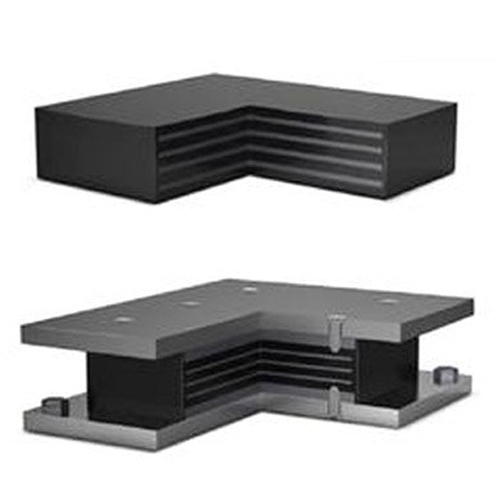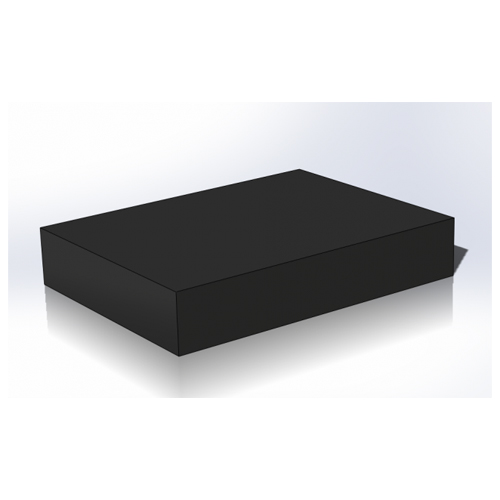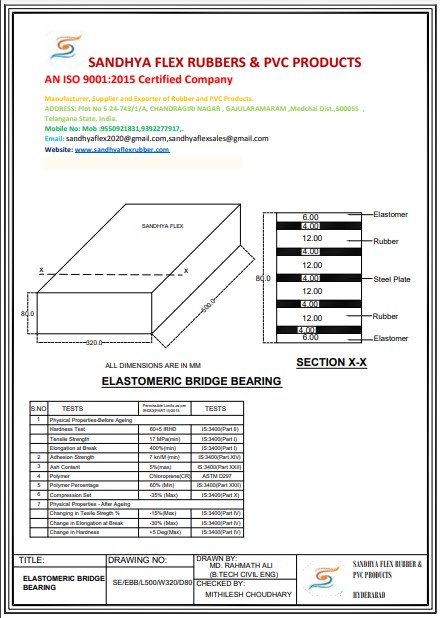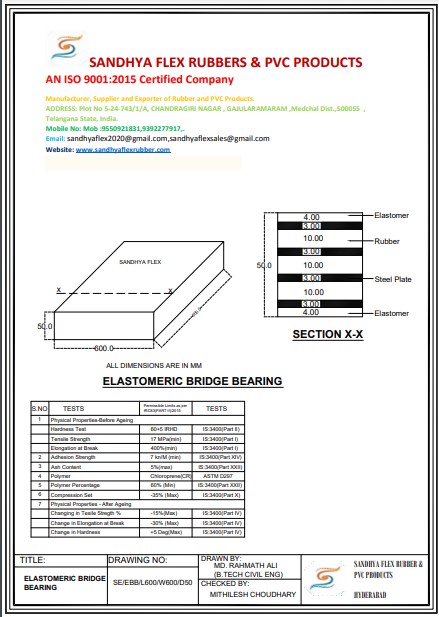Elastomeric Bridge Bearing
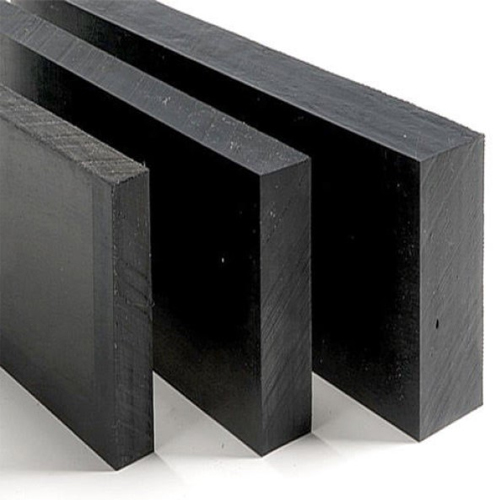
Sandhya Flex Rubbers & PVC Products provide high quality Elastomeric Bridge Bearings, also called Neoprene Bridge Bearings, Bridge Bearing and elastomeric bearings. These bearings are manufactured using high grade materials (CR, Black Carbon Reinforcement, and Other Chemical with the aid of contemporary techniques at our advanced production unit. The bearings provide adequate support to bridges for absorbing vibrations and preventing their deformation. In addition, we offer these Elastomeric Bridge Bearings at value for money prices.
Features
- Extended durability
- Excellent flexibility under lateral load
- Easy to install
We are one of the eminent manufacturers and suppliers of Elastomeric Bridge Bearing Pads. These pads are manufactured using the finest quality material, procured from reliable vendors under the observation of seasoned professionals. Offered pads are checked at our well-equipped facility on various parameters to ensure its long service life. These pads provide economical solution which are used to withstand loads and deformation in any direction for the construction of large-span bridges and buildings. Elastomeric Bridge Bearing Pads are available at our industry in reasonable prices.
Application
Laminated elastomeric bearing or neoprene bridge bearing pads are simple to install as contrast with different sorts of bearings deployed and demand zero handling. Dissimilar to numerous elastomer, neoprene rubber experiences no marked contraction at least temperatures when bridge neck thermal contraction is performed at optimum; as such contraction can be harmful to structure and bearing. Suitably compounded and precisely outlined bearings can be anticipated to work productively for minimum 15 years.
As utilitarian bearings for sell beams, pre-stressed concrete or pre-cast concrete in buildings and bridge are imperative, our elastomeric bridge bearings allow uniform and smooth transfer of load through beam of the frame as well as permit beam revolution for bearings because of beam deflection under load. These also permit longitudinal and lateral beam movement that is induced by heat pressures. They do not possess any movable components. In addition, thermal contraction and expansion are assimilated by ability of pad to offer and take shear. No sliding movement between pad and abutment or between pad and beam is present.
Benefits
Our bridge deck are composed of numerous elastomeric material laminates that is separated through steel supports. The complete bearing size and laminate thickness is as per demand of transferred load. Bearings possessing steel plates are supported should be compresses or cast vulcanizes or molded as one unit in mold below heat and pressure
Testing Of Our Bearings
In house manufacturing test of every bearing is completed in the presence of the client or his representative. Trials adhere to IRC 83 PART II/UIC772, Spec – EN-1337-3. Particulars are as per affirmed examination on either level 2 or level 1 or long and short duration’s compression trails of approximately 800 ton with levelled shear load of around 150 ton can be tested in our facility
Four Type of Test Conducted on Finish Bearing after 7 day of Manufacturing before 6 month as per specification
1. Elastic Modulus Test:
Elastic Modulus Test, Modulus of Elasticity, also known as Elastic modulus, represents an objects resistance to elastic deformation when force is applied. When viewed on a graph it is the ratio of the stress in a body to the corresponding strain. i.e. ratio of Force in a body to the Displacement.
2. Shear Modulus Test:
The shear modulus is again measured from the unloading portion of the stress-strain curve, as in uniaxial compression testing. The shear strength is taken as the maximum stress. The standard deviation in the shear strengths of aluminum foams are similar those for the compressive and tensile strengths.
3. Adhesion Strength:
Adhesive strength refers to the ability of an adhesive to stick to a surface and bond two surfaces together. It is measured by assessing the maximum tensile stress needed to detach or unstick the adhesive perpendicular to the substrate. The adhesive strength is the maximum tensile stress possible at the interface.
4. Compression Test:
Compression tests are used to determine a material’s behavior under applied crushing loads, and are typically conducted by applying compressive pressure to a test specimen (usually of either a cuboid or cylindrical geometry) using platens or specialized fixtures on a universal testing machine
Role of the Elastomeric Bearing Pad
Preventing collapse is not the only function of an elastomeric bearing pad. The pads extend the life of bridges by reducing wear and tear on bridge materials. The pads help governments save money by delaying the replacement of bridges, much like the way shoes allow human beings to walk long distances
ELASTOMERIC DESIGN 3D Engineering Simulation In Bridge Design
Finite element analysis of a bridge elastomeric bearing pad carried out with SimScale
Because bridge elastomeric bearing pads are crucial for a safe and cost-effective bridge design, they are extensively prototyped and tested before they are used in production
Using a simulation software like SimScale as part of the process, it is possible to virtually test an elastomeric bearing pad under different design and load assumptions. For example, the bearing pad can be assumed to be composed of an elastomeric material reinforced by steel plates, and three basic load cases can be simulated and observed: 1) compression, 2) compression with shearing, and 3) compression with rotation
The results can be analyzed by observing Cauchy stresses in a contour plot. One can even observe that with the introduction of steel plates, the load-carrying capacity of the bearing is enhanced.
Conclusion
As we have seen, designing elastomeric bearing pads using simulation software play a crucial role in bridge safety, dependability, and longevity. If you want to give it a try, create a free Community account here and then copy this template of an elastomeric bearing pad simulation, change the settings or the CAD model and perform your own analysis.
You can learn more about the role of engineering simulation in construction applications by downloading a free infographic here.
Set up your own simulation via web in minutes by creating a free account on the SimScale platform. No installation, special hardware or credit card is required
The Bay Bridge was designed to withstand earthquakes by implementing technology that allowed the bridge to adapt to such dramatic environmental instances. In fact, all bridges are designed to be moderately flexible with an embedded “bend or break” design philosophy; it is assumed that the bridge will be subject to somewhat unpredictable external forces and torques caused by high wind speeds, temperature changes, heavy traffic, and sometimes even earthquakes
Properties of Elastomer
| Physical Properties | Unit | Specified | Test Method | |
| 1 | Hardness | IRHD | 60 +5 | IS:3400 (Part II) |
| 2 | Minimum Tensile Strength (Moulded Test Piece, Test Piece from Bearing | MPa | 17.0 14.0 | IS:3400 (Part I) |
| 3 | Minimum Elongation at Break (Moulded Test Piece, Test Piece from Bearing | % | 400 350 | IS:3400 (Part I) |
| 4 | Maximum Compression Set (24h,100 +1oC) | % | 35 | IS:3400 (Part X) |
| Accelerated aging (72h,100 +1oC) Maximum Change from un-aged Value | ||||
| 5 | Maximum Change in Hardness | IRHD | +5 | IS:3400 (Part IV) |
| 6 | Maximum Change in Tensile Strength | % | -15 | IS:3400 (Part IV) |
| 7 | Maximum Change in Elongation | % | -30 | IS:3400 (Part IV) |
| 8 | Shear Modulus at Nominal Temperature | G.MPa | 0.9 (+0.18) | |
| 9 | Ash Contant | % | 5. Max | IS:3400 (Part XII) |
| 10 | Plymers | % | 60.0min | IS:3400 (Part XII) |
Typical Size of Laminated Bearings
|
Dimension EBB |
Dimension SL |
No of S |
Total Thick of Steel mm |
Total Middle Elastomer Thickness |
Total Top and Bottom Elastomer Thickness |
Thick |
No of |
Thick |
No of Layer |
Total |
|||||
|
Length |
Width |
Thick |
Length |
Width |
Thick |
||||||||||
|
1 |
100 |
100 |
25 |
88 |
88 |
3 |
3 |
9 |
8 |
8 |
4 |
2 |
8 |
1 |
25 |
|
2 |
200 |
100 |
30 |
188 |
88 |
3 |
2 |
6 |
16 |
8 |
4 |
2 |
8 |
2 |
30 |
|
3 |
200 |
200 |
33 |
188 |
188 |
3 |
3 |
9 |
16 |
8 |
4 |
2 |
8 |
||


